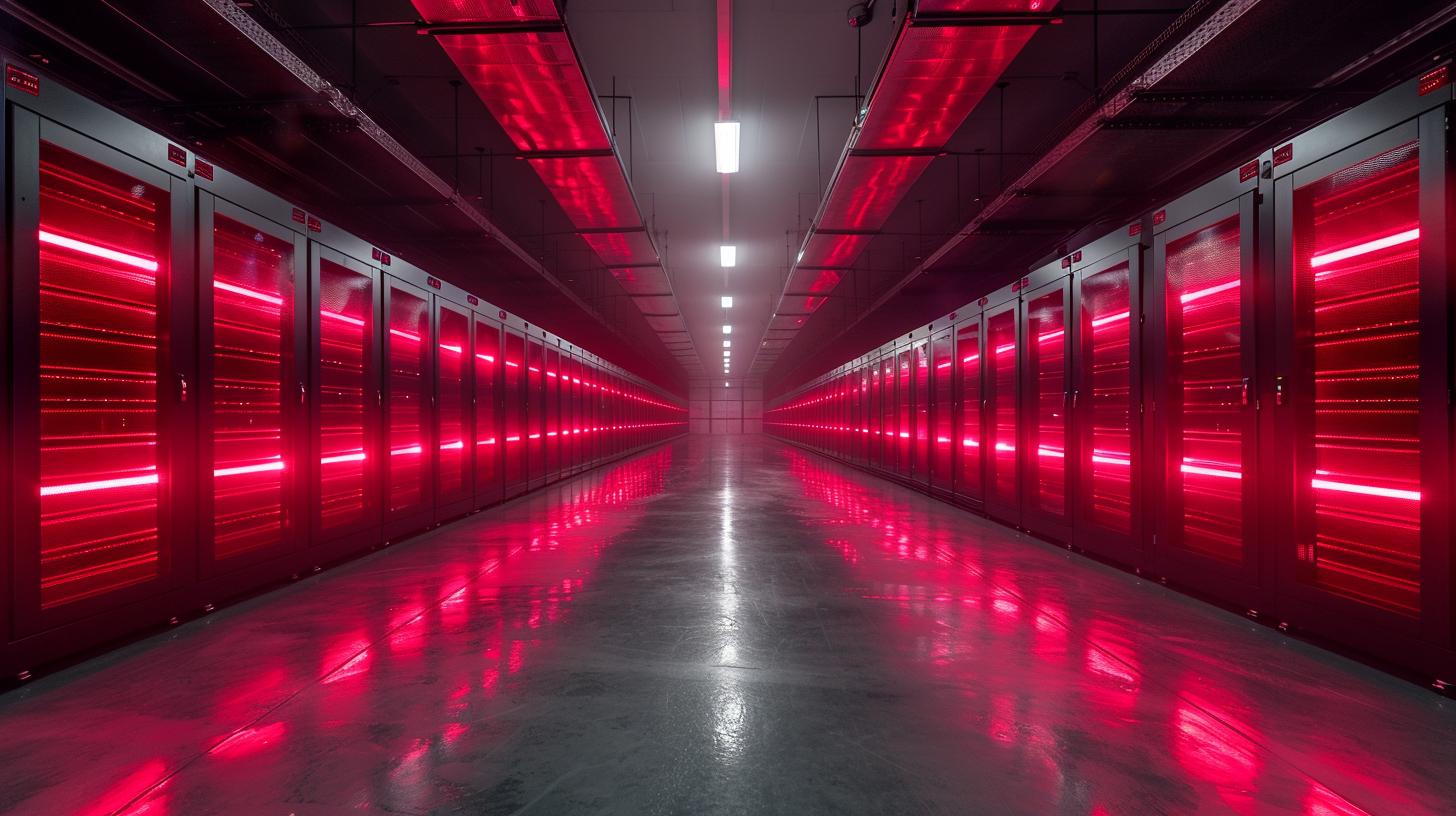The rapidly expanding digital economy has put server optimization for cryptocurrency mining in the spotlight as never before. Faced with high energy consumption, disruptions, and increasing operation cost in running a successful crypto mine, technology has stepped up to provide a solution; enter Data AirFlow. Revolutionizing how server sourcing is done for cryptocurrency mining, Data AirFlow is creating waves in this domain by providing optimal performance and efficiency.
To understand its significance, it’s essential to dive into what Data AirFlow entails in detail. At its core, it’s a tech-driven approach designed to maximize computing power while minimizing energy waste. The key lies in managing the data flow within servers efficiently enough that they perform at their peak levels consistently. This method brings about profound implications for cryptocurrency mining – an operation heavily reliant on efficient server function and processing power.
Furthermore, the role of servers within cryptocurrency mining operations might appear straightforward but underestimates the overall complexity of the task at hand. A characteristic feature of effective cryptocurrency mining lies at the heart of excellent server utilization – more than just process power; it involves honing aspects such as uptime, power-usage effectiveness (PUE), failure rates, etcetera.
By incorporating Data AirFlow into these areas analytics can be used to streamline operations leading to an increase in profits or decrease in operational costs for your crypto mine.
In all honesty, this only scratches the surface regarding what harnessing Data Airflow can do for your blockchain operations. With that said, let’s delve deeper into the world of optimized server sourcing and find out how you can truly leverage this game-changing innovation.
Unpacking the Basics
Before diving into the intersection of Data AirFlow and cryptocurrency mining, it’s important to understand each component separately. Data AirFlow is a new cutting-edge technology focused on optimizing server utilization in various data-focused situations by enhancing how data is transferred and processed. On a more granular level, this technology optimizes server sourcing by predicting processing capabilities, preventing system malfunctions, and improving overall system efficiency.
Understanding Cryptocurrency Mining
The process of cryptocurrency mining can be complex; in simple terms, it involves using computer systems to solve intricate math problems that validate digital currency transactions. Miners who successfully solve these puzzles are rewarded with units of cryptocurrency.
Since the process heavily relies on computational power and speed, mining operations need to regularly source servers-a hardware infrastructure that supports significant calculations per second-to maintain or improve their profitability. This necessity pinpoints the growing importance of server optimization in cryptocurrency mining.
Data AirFlow: A Game Changer for Server Sourcing
Server sourcing refers to the strategic decision-making process involved in selecting appropriate servers based on factors like processing speed, storage capacity, energy efficiency, durability, flexibility, and cost-effectiveness-parts vital for successful crypto-mining operations. Data AirFlow offers an ingenious solution to streamline this traditionally complicated process. Through leveraging accurate predictive analysis regarding a server’s processing capabilities along with identifying potential system malfunctions before they occur effectively mitigates suboptimal performance risks while increasing business productivity and efficacy.
Data AirFlow functions by constructing robust simulation environments that predict how information will travel across designated networks under specified workloads. In doing so, this technology empowers organizations to preemptively identify what type of server they’ll require-based on their unique operational needs-and where bottlenecks may occur.
Together these two components-cryptocurrency mining and Data AirFlow-deliver synergistic benefits when combined properly. By employing result-oriented techniques like Data AirFlowserver optimization, cryptocurrency mining becomes significantly more profitable and sustainable. The following sections will delve deeper into this relationship, offering a comprehensive guide for implementing these practices into your own cryptocurrency mining operations to maximize profitability and enhance system performance.
The Critical Role of Servers in Cryptocurrency Mining
The Significance of Server Optimization in Cryptocurrency Mining
In the world of cryptocurrency mining, the role of servers is nothing less than crucial. Servers are the workhorses that shoulder the computational load required to run complex algorithms – a fundamental process within the mining operations. Their efficiency directly impacts the speed of transactions, ultimately influencing profitability. Given these realities, server optimization cryptocurrency mining has become a focal point for miners looking to enhance overall performance and boost revenues.

Server optimization involves tweaking server settings and infrastructure to maximize performance and reduce latency. This can involve selecting higher-end hardware with turbo clocking capabilities or adjusting software settings for increased operational efficiency. Achieving an optimal balance between processing power and energy consumption is paramount here; inadequate server management can lead to inefficient energy use and skyrocketing operation costs – both detrimental to profit margins.
The Intersection Between Server Sourcing and Cryptocurrency Mining Success
The sourcing aspect plays an integral part in successful mining operations – getting the right servers with compatible processing power ensures efficient computing procedures for algorithmic operations involved in cryptocurrency mining. To put it plainly, better servers usually mean improved hash rates which translates directly into more successful mining endeavors.
However, even superior servers have their limitations – particularly when it comes to handling vast amounts of data continuously. If not managed efficiently or sourced appropriately considering factors like scalability, resilience, and future growth projections, they can tire over time causing slower transactions or worse, system failures that can derail entire operations.
Data AirFlow: Redefining Server Efficiency for Crypto-Mining
This is where Data AirFlow technology holds immense promise by helping miners source their servers effectively while optimizing them systematically. Leveraging advanced computational models that forecast and predict processing capabilities according to varying data loads, Data AirFlow diffuses potential system malfunction threats before they occur.
By integrating continuous learning systems into its methodology along with predictive analytics engines – this powerful technology delivers real-time insights and trend-based projections that help crypto miners make informed decisions regarding server sourcing and optimization. Expectantly, this results in ensuring that a mining operation’s servers are always running at top efficiency to maintain productivity levels for sustained profitability.
How Data AirFlow Can Refine Server Sourcing for Your Crypto Mine
In the complex domain of cryptocurrency mining, where efficiency significantly influences profit margins, server optimization is a critical element. As a result, the demand for advanced solutions that can streamline and enhance server sourcing in cryptocurrency mining has grown exponentially. This is where Data AirFlow technology comes into play. It offers an innovative solution that aids in predicting processing capabilities, averting system malfunctions, and enhancing overall mining operations effectively.
Data AirFlow predominantly works by improving the network’s bandwidth while maintaining high-speed data transfer within servers. It employs machine learning algorithms to conduct predictive analytics on server performance. By predicting possible processing difficulties or system malfunctions before they occur, it empowers miners to take precautionary measures to resolve these issues ahead of time:
- Predictive Maintenance: Foreseeing potential machinery faults allows miners to maintain hardware effectively.
- Efficiency Bump: By accurately predicting the processing capabilities, miners can optimize their operations accordingly leading towards enhanced productivity.
- Network Overheads: Reducing network overheads during peak times ensures smooth running without any interruptions.
In terms of increasing efficiency in the context of server optimization cryptocurrency mining manners drastically benefits from Data AirFlow technology. The tech evaluates performance metrics like CPU utilization, memory use, disk I/O, and network traffic patterns ensuring optimal operation of the servers in the interest of maximum profit generation.
This real-time analysis not only improves operational efficiency but also serves comprehensive insight into potential areas of improvement – a feature that cryptocurrency miners immensely stand to gain from:
- Tweaks System Configuration: Based on the measurements collected from various servers within a given setting or environment, Data AirFlow allows for refining system configurations for better results.
- Pro-active Measures: Knowledge about which component might become a bottleneck helps implement pro-active measures leading towards efficiency gains.
- Congestion Control: Understanding network traffic patterns prevents congestion control and ensures smoother data transfer.
Employing Data AirFlow for server sourcing gives your cryptocurrency mining operations a significant advantage. Remember that in this demanding digital venture, the key to optimizing profit margins lies in transforming operational efficiency – a task at which Data AirFlow excels.

Practical Steps to Employ Data AirFlow in Optimizing Your Cryptocurrency Mining Servers
Once you understand the rationale behind Data AirFlow and its use in server optimization for cryptocurrency mining, employing it efficiently becomes the logical next step. To begin this journey, the first step is selecting a Data AirFlow system that aligns with your operation’s scale, budget, and processing demands. Broadly speaking, there are several well-regarded systems prevalent on the market today specifically designed to facilitate optimal performance in cryptomining servers.
After identifying the appropriate Data AirFlow system for your needs, installation comes second in line. The intricacies of installing this technology may vary depending on the chosen system but generally involves integrating sensors into your server spaces that will monitor parameters such as temperature, pressure, humidity, and air flow velocity among others.
These sensors feed real-time data into an analytics platform which then uses these inputs to control and optimize cooling operations. Ensuring that this setup is done correctly is fundamental to capturing accurate data that truly reflects operating conditions within your cryptomining operation.
Finally, perhaps the most critical part of the process after installation is continuous monitoring and adjustment. Even after deployment of a Data AirFlow system intended for server optimization cryptocurrency mining operations should not be complacent about their cooling needs.
Factors external to your mining operation – such as environmental conditions – can change rapidly and unexpectedly thereby degrading performance if left unchecked. Continuous real-time monitoring allows timely reaction to any adverse changes in conditions thus preventing any sudden disruption in mining activities due to server malfunction or overheating issues.
Following these steps will provide you a good foundation from which you can harness the full potential of employing Data AirFlow technology in optimizing server sourcing for cryptocurrency mining operations. As always though with anything related to tech infrastructure: one solution does not necessarily fit all scenarios so keep abreast with advancements or perhaps consider consulting an expert who can tailor strategies specific to your needs.
Case Study
One stark example of the fruitful combination of Data AirFlow and cryptocurrency mining is a significant high-performing mine located in Arizona. This mining operation was struggling to optimize its server sourcing strategy, thus affecting efficiency. Recognizing the growing need for server optimization in cryptocurrency mining, they turned to Data AirFlow technology. Utilizing this cutting-edge technology, they were able to analyze data flow patterns, enabling them to predict processing capabilities accurately and prevent system malfunctions, thus increasing overall productivity.
The successful utilization of Data AirFlow technology led to tangible changes within a few weeks. Prior to implementation, the mine had an average block discovery time of 10 minutes per block mined. After implementing Data AirFlow optimization strategies, this time significantly decreased to 7 minutes per block mined – a staggering 30% decrease in processing times. Furthermore, there were zero instances of system failure resulting from overloaded servers since the integration.
| Before Data Airflow Optimization | After Data Airflow Optimization |
|---|---|
| Average Block Discovery Time: 10 Minutes Pet Block Mined | Average Block Discovery Time: 7 Minutes Per Block Mined |
| Instances of System Failure due to Overloaded Servers: Several Occurrences | Instances of System Failure due to Overloaded Servers: Zero Occurrences |
Furthermore, as part of their implementation strategy, the mining outfit integrated data and server visualization tools for continuous feedback and adjustments. Continuously monitoring performance metrics helped them employ real-time adjustments leading to sustained system optimizations. In conjunction with higher processing speed and lower failure rate, this led to increased profitability by causing less downtime due to system failures typically associated with inefficient server sourcing.
Conclusion
In sum, coupling Data AirFlow and server optimization in cryptocurrency mining can greatly improve the efficiency and success of your operations. From its ability to anticipate processing capabilities to preventing system malfunctions, adopting this breakthrough technology can transform your server sourcing practice. By reducing downtimes and enhancing outputs, you will be positioned to stay competitive and profitable within the ever-evolving crypto market.

There are practical steps available for those seeking to take advantage of this technology. While the successful implementation may require a thorough understanding of both Data AirFlow and cryptocurrency mining processes, the potential rewards make it worth considering. Furthermore, myriad real-world cases shed light on effective strategies for overcoming potential challenges in integration, making transition smoother.
In embracing future advancements with Data AirFlow in your crypto mine, you’re not merely improving current operations but also stepping forward into a future where data and server optimization cryptocurrency mining are seamlessly entwined. As innovation progresses unabatedly in this arena, staying attuned to related technological trends is key to maintaining your firm’s leading edge over competitors.
Therefore, utilizing Data AirFlow is not only an immediate solution but a strategic standpoint ensuring smooth adaptation in the midst of continuous evolution in cryptocurrency mining practices.
Frequently Asked Questions
How Do I Optimize My Computer for Crypto Mining?
Optimizing your computer for crypto mining involves a few steps. First, ensure that your system meets the minimum specifications necessary for efficient mining. This includes having adequate RAM and a capable graphics processing unit (GPU).
It’s also essential to keep all software, especially the operating system and mining applications, up to date. Using a dedicated mining operating system can optimize the process further. Always ensure your computer is cooled sufficiently to avoid overheating during the extended computations involved in mining.
Which Algorithm Is Best for Crypto Mining?
The best algorithm for crypto mining would depend on factors such as the type of cryptocurrency being mined and the equipment being used. SHA-256 is ideal for Bitcoin mining while Scrypt is suitable for Litecoin or Dogecoin. Ethash works great with Ethereum, while Equihash suits Zcash perfectly.
X11 has been designed for Dash and CryptoNight fits Monero well. You should choose an algorithm based on these parameters along with electricity costs and potential profitability.
What Is the Most Profitable Form of Crypto Mining?
The most profitable form of crypto mining often changes based on factors like market price fluctuations, cost of electricity, and technological advancements. These variables determine which cryptocurrencies are more lucrative to mine at any given time.
For example, Bitcoin was historically one of the most profitable to mine but ever since its growing popularity led to increased competition, other options have started becoming more popular.
What Is a Crypto Mining Server?
A crypto mining server is essentially a specialized computer designed specifically to handle cryptocurrency mining tasks efficiently. They are typically equipped with high-performance GPUs or ASICs (Application-Specific Integrated Circuits), abundant RAM and cooling systems to handle extended workloads without overheating issues common in conventional computers used for prolonged mining activities.
Does RAM Affect Crypto Mining?
RAM does have an effect on crypto mining but it’s typically minimal compared against the role played by GPUs or ASICs which carry out intensive calculations involved in solving transactions blocks – this is because most cryptocurrencies don’t need much memory allocation unlike certain graphic-intensive operations or multitasking applications which rely heavily on RAM.
How Do I Optimize My GPU for Mining?
To optimize your GPU for mining, you should ensure your graphics card drivers are up-to-date. The GPU’s clock speed can be adjusted to a stable higher frequency for better performance, although this may increase power consumption and heat output.
The memory speed of the GPU can also be increased for better hash rates. Additionally, making sure the GPU unit is adequately cooled will help it run efficiently for longer durations.
What Is the Best Laptop Configuration for Crypto Mining?
The best laptop configuration for crypto mining would typically include a powerful processor, ample amount of RAM, and a high-end graphics card. Since crypto mining is power-intensive, laptops with robust cooling systems are preferred to prevent thermal throttling or possible damage due to overheating during prolonged periods of mining operations.
How Do I Increase My CPU Hash Rate in Mining?
You can increase CPU hash rate in mining by overclocking the CPU which involves increasing its operating frequency beyond manufacturer-recommended levels to achieve greater computation speeds although this leads to increased heat output and potentially reduced lifespan.
It’s suggested to have appropriate cooling measures when utilizing such methods while being cautious not to push too far beyond limits to avoid risking hardware failure or damage.




